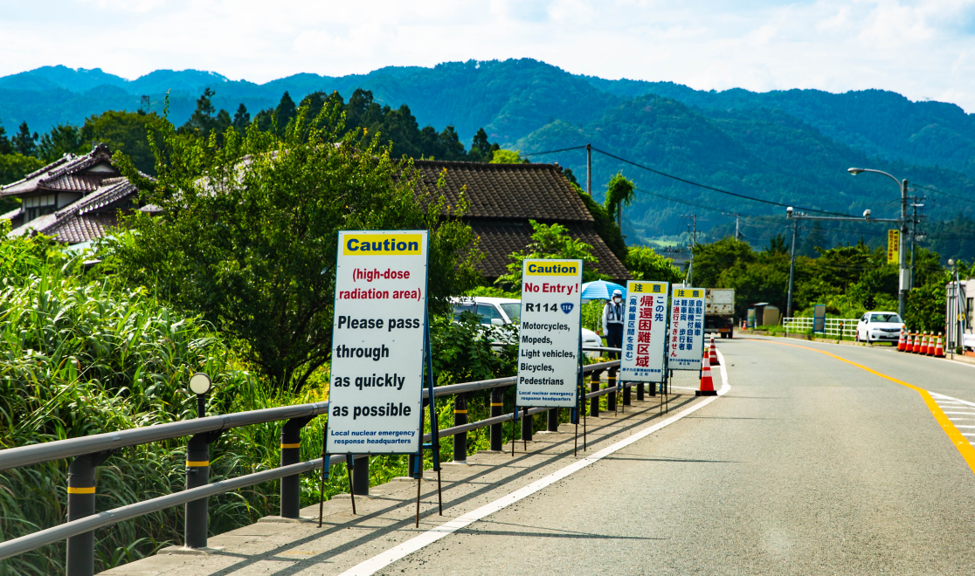Abstract: The Japanese government’s manipulation of athleticism and consumerism to make Fukushima’s radiation problems appear irrelevant takes the Olympics into dangerous new levels of state coercion. This essay urges making radionuclides visible—even metaphorically humanizing them—to grasp the ongoing threat to the people, land, and water that inhabit the ongoing Fukushima nuclear crisis.
Japan’s 1964 “Recovery Olympics” sought to rebrand Japan to the international community from wartime enemy into international partner and friend. The Olympics were an excellent choice.
The upcoming 2020 “Recovery Olympics” is not about rebranding Japan. Instead, it is about rebranding unstable radioactive elements from everyone’s enemy into something Japanese authorities hope that a “smile” makes less treacherous. These upcoming Olympics distract from the consequences of the three nuclear reactor meltdowns in Fukushima that began nine years ago.
What happened in Japan on March 11, 2011 is overwhelming. Initially named the “triple disasters,” focus now centers on one problem: the ongoing crisis at the Fukushima Dai-ichi nuclear power plant. It would be different had the calamities that struck northeastern Japan solely been a once-in-a-thousand-year earthquake and tsunami. If so, the upcoming Tokyo “Recovery Olympics” could be better held in the hard-hit city of Sendai to showcase surrounding communities that have moved forward from that terrible day. Unfortunately, however, the Fukushima reactor meltdowns that began with the region’s other catastrophes created a forever crisis still too dangerously unstable to make this possible.
State-sponsored sun-filled forecasts nonetheless abound, many without even a hint of irony such as the Foreign Ministry’s Hisajima Naoto’s recent explanation to a reporter from the American television network NBC (which will broadcast the Olympics) of the purpose of the Tokyo games: “It’s an opportunity for Japan to change people’s perception, people’s view of Fukushima.”
In 2013, Prime Minister Abe Shinzo scored the 2020 Olympic bid for Tokyo by promising the world that the situation at the Fukushima Dai-ichi nuclear power plant was “under control.” In 2016, he sealed the deal by dressing up as a video game character. From a certain perspective, there is nothing unusual about this. Leaders have worn costumes and lied across history to make audiences believe what they want: President George W. Bush’s 2003 “Mission Accomplished” appearance aboard the USS Abraham Lincoln comes to mind. That said, even Mikhail Gorbachev did not bring the Olympics to Moscow to cover Chernobyl’s problems or to try to hold the Soviet Union together.
The low-level ionizing radiation that permeates areas of Fukushima will not kill Olympic athletes or their supporters who visit the torch relay, baseball, and softball games. It is highly unlikely that any will suffer after-effects from such minimal exposure. That said, using Olympic athletes—people with extraordinary physicality—to make unseen radionuclide enemies appear inconsequential compounds and denies the ongoing challenges faced by the people, animals, land, and water that live in these areas by choice or having no economic option.
Moreover, using Olympic athletes to claim that Japan will “never become complacent with nuclear safety” confirms Japan’s myth as the international norm. Locals are further sacrificed to this fantasy, and the rest of us are made complicit in the state’s maneuver. If you protest, you are a “traitor.”
State-sponsored disaster tourism
Some may argue that the Olympics is always a charade: the 1936 Berlin games sought to divert attention away from Hitler’s expanding terror; in 2016, the Brazilian government attempted to shift the world’s gaze from the structural inequalities that plague Rio de Janeiro. Fair enough. Yet, the Japanese government’s manipulation of athleticism and consumerism to make Fukushima’s radiation problems appear irrelevant takes the Olympic program—and, again, the athletes—into newly dangerous levels of state-led coercion.
Defining “terrorism” is notoriously slippery: one person’s terrorist is another’s freedom fighter. That said, for the sake of grasping the dangers that Fukushima’s residents live with on a daily basis—not to mention the land, river, and sea creatures—what happens if we were to humanize radionuclides and make them visible? Different from the difficulties involved in naming someone a “terrorist,” cesium, for example, knows no political, economic, or religious impulse. Tritium is not a Japanese word. No matter how much the Japanese government massages meaning otherwise these and other radionuclides affecting areas of Fukushima will continue to threaten and harm the people, the land, and the Pacific Ocean for at least the rest of this century—if not longer.
The Japanese state apparatus and its backers—not in the least the International Olympic Committee—would have the world believe otherwise, relying on radiation’s invisibility to buttress the untrue yet pervasive notion that long-term exposure to low levels of radiation is not worrisome. But it is, as studies from Hiroshima, Nagasaki, the Marshall Islands, Hanford, and Chernobyl show.
In December 2019, the international environmental group Greenpeace publicized studies of areas along the planned Olympic torch route displaying high levels of radiation. International efforts to discredit Greenpeace and its science as “leftist” work for popular consumption, yet what about the Japanese government’s own measurements? During two day-long trips in August 2019 to publicly accessible sites along the planned Olympic torch route, government installed devices revealed levels of radiation numerous times higher than is safe for human habitation as was acknowledged in several road-side signs in Japanese and English.
|
Near the town of Namie, August 2019 (photo: Andy Marks) |
|
Caution signs include prohibiting pedestrians, August 2019 (photo: Andy Marks) |
Olympians and their supporters will run right through these areas, with international television cameras beaming scenes of cheering spectators and pretty countryside around the world. At the same time, recognizing environmental contamination with radionuclides would underscore the criminality of using the Olympics in this state-sponsored disaster tourism scheme.
|
Grass-cutting across from the Fukushima Dai-ichi plant, August 2019 (photo: Andy Marks) |






